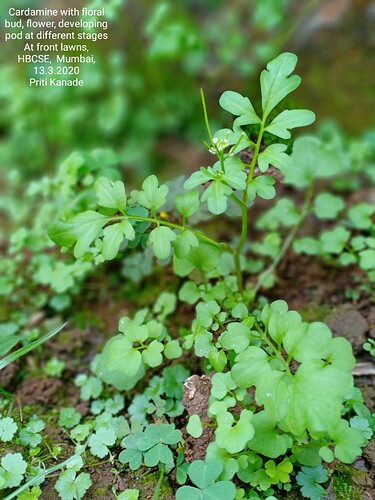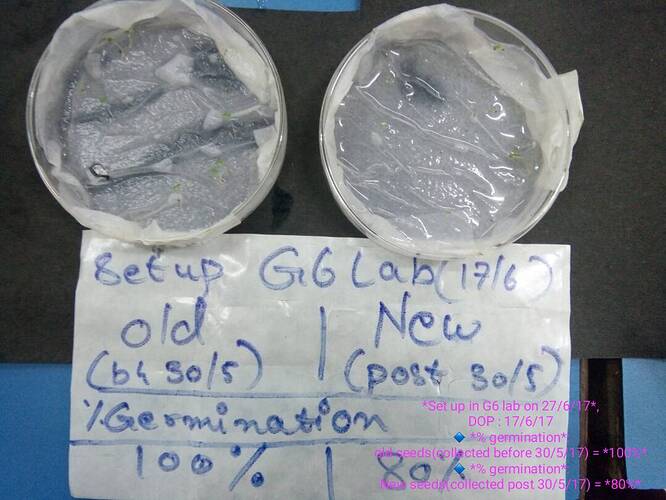- make required solution containing
Agrobacterium with plasmid with selectable marker
Required growth medium
And detergent preferably silwet which they mention - take cardamine plants to get at least 100 floral buds
So that we get at least few transformed seeds - dip cardamine buds in this solution under low vacuum
- remove and wrap with plastic bag to retain moisture
- after exact 24 hours( not later than 24,crucial)
Remove the bag - repeat the process after 4 days
- collect all the seeds, since the pod bursts we should see to it
We collect all seeds as soon as pod matures - subject seeds to Kanamycin solution
- we’ll get transformed seeds!
I am not sure why low vacuum is required at all! @Priti_Kanade
I’m sorry
With this method we don’t need low vacuum
Please mention the role of sucrose and detergent silwet that you are using in this protocol
I would like to see your results, if possible post some pictures of transformed Cardamines , or pictures that you have taken while performing this protocol.
I have not performed the given experiment yet
Angela Hay et al from Max Planck Institute
Have worked on this
Sucrose helps in maintaining the required osmosis and detergent helps entry of our plasmid in the ovules of plant
Floral dip: a simplified method for Agrobacterium ‐mediated transformation of Arabidopsis thaliana
First published: 09 October 2008
https://doi.org/10.1046/j.1365-313x.1998.00343.x
Citations: 8869
The labor‐intensive vacuum infiltration process was eliminated in favor of simple dipping of developing floral tissues into a solution containing Agrobacterium tumefaciens , 5% sucrose and 500 microliters per litre of surfactant Silwet L‐77. Sucrose and surfactant were critical to the success of the floral dip method. Plants inoculated when numerous immature floral buds and few siliques were present produced transformed progeny at the highest rate.
Look at this quote from the abstract of article by Steven J. Clough
Understanding the Life Cycle of Cardamine with land marks and time taken to reach, like
(a) seed germination
(b) simple leaf formation
(c) compound leaf formation
(d) flowering
(e) fruiting
(f) ripening of fruit
(e) collection of seeds
Note:
The below observations are taken in 2017 and mentioned in Cardamine lab record book 2017
It takes approximately 6DPS ( Days post sowing ) for seeds to germinate and observe cotyledons
Post 6 days, that is :
12DPS, it bears first simple leaf and on
18DPS second simple leaf
24DPS - First compound leaf, that is third leaf of the plant, it has been observed it has 3 leaflets
30DPS - Second compound leaf, that is fourth leaf of the plant, it has been observed it has 3 leaflets
36DPS - Third compound leaf, that is * Fifth leaf* with 5 leaflets
42DPS - Fourth compound leaf, that is * Sixth leaf* with 5 leaflets
Along with sixth leaf, * green floral bud* is observed
(sometimes it was observed with seventh leaf, we need to carry out population study for observing which one has maximum frequency)
![]() Next question is how much time it takes :
Next question is how much time it takes :
Floral bud with green sepals
![]()
Floral bud with green sepals and white petals seen in between
![]()
Floral bud with green sepals and white unopened petals
![]()
Full bloomed flower
(This observation needs to be taken crucially therefore needs utmost following up)
@45DPS - From green bud with sepals to full bloomed flower : approx 3 days ,
(it is the time we can do _ floral dip_ )
55DPS - * From flower to mature pod which will burst to give seeds which can be sowed * : approx 10 days, need to verify this with good sample population
This we require as we should know when we should be ready to collect seeds once we perform floral dip (else they’ll get lost, and we can’t afford to do that)
The seeds are present on both sides of the silique, collect by touching the ripe fruit pod which bursts on touching.
![]()
Hence we can say that it takes approx 2 months i.e. 55-60 days from seed to seed in Cardamine😇
- Priti and Cardamine team😇
As mentioned in the notes and pointers
Many things are yet to be studied
For example:
Development of bud ![]() flower:arrow_right: pod
flower:arrow_right: pod
We need to find answers for all questions by studying and observing the development for a population of plants😇
Cardamine collection from mature seed pod by @GN 3 August 2017
Good beginning! @Priti_Kanade
- Who are your Collaborators?
- What were the limitations of your study?
- Do you want to celebrate any Goof- ups?
- What messages you want to pass on to your current collaborators and to future entrants?
-
My collaborators were Abhijeet, Arjun, Pratik, Binita
-
Limitations : Since we all were in school or college, we couldn’t give enough time
-
Yes,
Initially we didn’t provide ample amount of water
Post causerie, we understood this -
Message: Plan, work, observe results - positive or negative
Learn
Experience
Cardamine with floral bud, flower, developing pod at different stages
At front lawns,
HBCSE, Mumbai,
13.3.2020
Chat from archives
Set up outside G6 lab on 27/6/17,
DOP : 17/6/17
% germination:
old seeds(collected before 30/5/17) = 70%
% germination:
New seeds(collected post 30/5/17) = 0%, that was very strange, we didn’t expect this! what could be the reason?
6/27/17, 13:34 - Priti: We had shared Cardamine seeds with Garima ma’am from Delhi(and with Jaipur group later)
So that they’ll cultivate Cardamine at their respective places
For this we should first understand what is the % germination of our Cardamine seeds
Therefore we designed a set up considering 2 factors:
Old seeds(collected before 30/5/16) & new seeds(post 30/5/17) inside G6
Temperature:17-24 degreeC
Outside G6
Temperature : 25-31degree C
6/27/17, 13:35 - Priti: From the above observations it is found that
old Cardamine seeds germinate better than new ones
Cardamine seeds germinate better at cooler temperature
Good to see an update on the Cardamine Model after a long time.
What do we mean when we say better germination?
What if we keep the new cardamine seeds at cooler temperature and then compare them with the old ones at the same temperature?
As you can see
It’s the second experiment performed wherein
Old seeds show 100%germination while new ones show 80% germination at cooler temperature
(Initial experiment is the one in which seeds were kept outside lab werein new seeds did not germinate till that date)
Did we have replicates to confirm that fresh seeds show zero per cent germination where as seeds, two months old(?!) germinates 100%? @Priti_Kanade
Let’s follow this up in CUBE ChatShaala discussions too…
Actually no
I did not have replicates
I should have kept
Then the results would be reliable…
Nazish from Mumbai is having a Cardamine patch in her Byculla Home Lab, we can get in touch with her and then look forward to replicating the same experiment at her place with replicates and controls. This asks for a design of the experiment with improvements from the earlier experiment.
@Priti_Kanade

